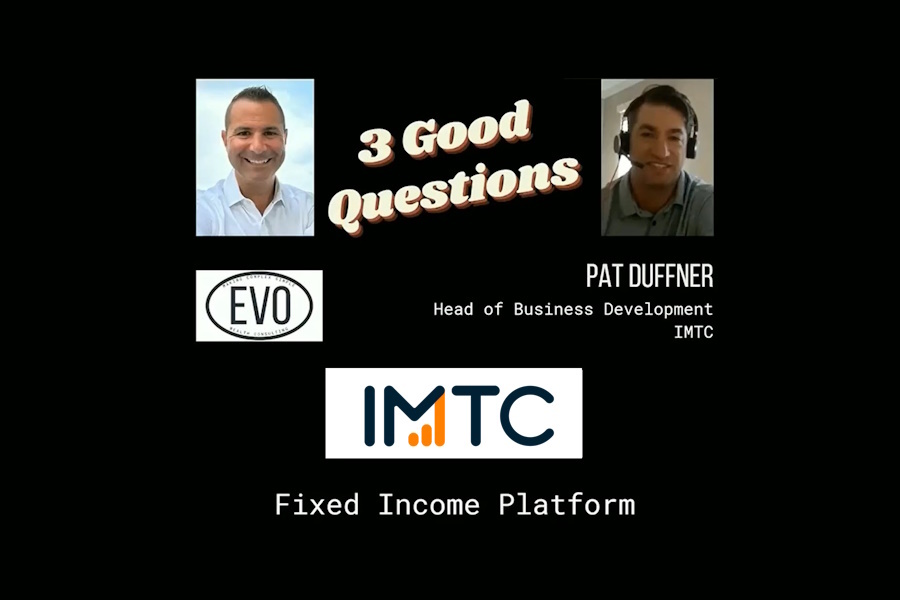5 Key Takeaways on the Future of Fixed Income from the 2021 Fixed Income Leaders Summit

As most in the fixed income community feel, the Fixed Income Leaders Summit provides investors an opportunity to share ideas on the top challenges and trends that will affect all firms. The 2021 U.S. summit, held on June 22-23, was no exception. As the world emerges from the pandemic and fixed income managers try to predict what the market recovery looks like, five key themes emerged from the conference, and we offer highlights from the discussions here.
1. Automation is a necessity to drive costs lower
Enhancing efficiency and workflow processes was the overarching theme that surfaced during most of the sessions – the common thread was the need to use technology and automation to keep costs down while improving investment decisions and client outcomes. The feeling is that automation will be necessary to scale firms and that is dependent upon having investment process streamlined and repeatable.
There was a clear agreement that technology can play a big role in identifying needs across portfolios and finding the right securities to address them. And, as one participant pointed out, “a lot more customization is available now; it’s not one size fits all anymore.”
- For SMA managers, doing this manually – one portfolio at a time – is too labor-intensive, and therefore costly, given the relentless fee compression in the industry. “Speed means you can offer customizable, bespoke solutions for clients,” noted one panelist.
- In today’s markets, trade decisions are often made in near real-time and the manual approach is too slow. For example, to review 100+ offers in a day, managers need to aggregate the available securities and optimize where to place them, especially in the muni market where there is a steep penalty for trading odd lots.
Jim Switzer of AllianceBernstein narrowed in on the need for portfolio optimization technology and connections into the OMS and EMS. Where previously, they were adding headcount to manual processes, now due to automation, they’ve kept the same headcount with a 700% trade flow increase and 18x faster investing timelines. We admit we were thrilled when he stated, “Had we seen IMTC’s technology two years ago, it might have prevented us from spending time and money trying to build our own tool to optimize and automate trades across portfolios.”
Panelists agreed that technology tools to improve trade and portfolio allocation decisions exist today but said that not all firms have made the leap to let go of their manual processes. One participant remarked, “we see a lot of ghosts from the past in fixed income markets, such as Excel and phones – a lot of fractured systems and workflows.” Firms that do not embrace productivity enhancements will struggle with higher costs in this “race to the bottom” fee environment. Everything will come down to moving faster.
2. The buyside needs better data aggregation tools, including real-time data
“Data is the building block of all things in the investment process, but it needs to be cleaned, and that’s a big, time-consuming challenge,” highlighted one panelist. Panelists view data, including real-time data updates, as critical to improving efficiency, but noted that organizing and using data productively is easier said than done. For all fixed income investors, connectivity is key. By aggregating data and systems, particularly with an OMS, EMS, venues, and risk/compliance data, firms can exponentially improve liquidity and their ability to deliver results to clients.
One panelist highlighted that “more data has allowed me to offer more robust offerings and bring new product to the market.” How is aggregated data providing other benefits to fixed income managers?
- Systematic trading: Data is the lifeblood of systematic trading, which allows traders to reduce time spent on low-touch trades and gives portfolio managers more time to focus on clients. It also lowers execution costs, all of which helps firms to survive fee compression.
- Interconnected systems: Systems that supply data need to be better connected. It’s not always easy to get a complete pre-trade picture, with the data needed to make the best trade decisions, including real-time data for pre-trade insights. There is a need to bring it all together. (Note: IMTC’s IMS connects across systems to provide pre- and post-trade insights.)
- Venue connectivity: Electronification of trading is enabling portfolio trading and all-to-all trading. There isn’t a platform that brings together all sources of liquidity. Yet, most did not think it was optimal to connect to more than a handful of dealers. What is the most important is to get aggregated liquidity in the OMS and EMS – that’s where the additive value is.
- Improved liquidity: Liquidity and data are related. More connectivity and more transparency are needed to aggregate the information that can give traders a better picture of liquidity. Innovation is occurring such as using liquidity scores in screening tools to identify opportunities.
3. Portfolio trading is here
Panelists had a good deal of enthusiasm about portfolio trading, which has shifted to something that is “here and now” and not a niche concept that only few are exploring. Portfolio trading really is about managing risk at a macro level – essentially, it is a solution for the macro questions being asked at FILS.
Portfolio trading has the potential to change workflows dramatically in a way that benefits both investment managers and their clients, including:
- Stronger risk management – “Without portfolio trading, a month-end rebalance could have hundreds of line items processed in batches. Even though we start early, some trades wouldn’t get done and risk carried overnight.”
- Improved efficiency – Portfolio trades lessen the burden on a trading desk, which might otherwise spend the entire day completing individual transactions. “Now I feel almost lazy – I just create a list and it will get done.” But that efficiency enables traders and portfolio managers to focus on providing more tailored services and investments for clients.
- Easier to achieve best execution – Portfolio trading allows the buyside to access liquidity more efficiently. Combining small odd lots into one portfolio trade can increase the chance of best execution. “We’re getting more competitive pricing and a high execution rate with portfolio trades.”
Of course, there are some caveats. It is important to have the right risk tolerance and mindset, and as portfolio trades are often linked to ETF developments, traders should know that unless they have an experience in ETF trading, only a few liquidity providers may be able to offer value. The consensus view: Despite the growth that has already occurred, the innovations offered by portfolio trading are just beginning. All-to-all trading may be the way of the future, and trading platforms should help the buyside to trade smarter and to construct better portfolios to maximize the pricing benefit. Panelists are excited to see portfolio trading evolve.
4. ESG matters…and it’s complicated
Sustainable investing continues to grow, in the U.S. and globally, and not just in equities. Fixed income professionals are feeling the impact of investors’ concerns about environmental, social, and governance (ESG) factors, in both the corporate and muni markets.
Conference participants noted the complexity of this issue. One keynote panelist observed, “it’s important to have a comprehensive understanding of ESG as a whole; it’s not just about saying you are ESG compliant but understanding what really goes into it.” Some of the top challenges around ESG for fixed income investors include:
- People tend to see ESG as a single issue, but E, S, and G are different things; for example, some sectors are particularly sensitive to environmental factors, while social and governance affect every sector, especially in credit spreads for long maturity bonds.
- Better technology and research capabilities are needed to help incorporate ESG data into the investment process, and ESG factors and inputs need to be more standardized.
- Green bonds are just one aspect of ESG investing in fixed income and there are questions about the “teeth” in penalties for issuers who do not use the proceeds of green bonds as intended.
- While there is clearly a risk of greenwashing (the sense that the issuer is claiming ESG benefits without delivering on them) across the entire sustainable investing landscape, there is a conviction that doing the right thing matters, and that “asset managers can do well by doing something good.”
5. All eyes remain on inflation
Of all the macroeconomic issues facing the fixed income markets, inflation is clearly front-and-center. Participants’ views differed: some felt supply chain- and labor-driven pressures were temporary, noting that the Fed’s pledge to raise rates sooner would be enough to calm markets; others felt the uncertain outlook for growh could lead to potential stagflation and a further risk of short-term inflation. Real yields are likely to remain low across developed markets, and in the long-term, demographics are a concern; an aging population means we’ll spend more than we save and that could cause yields to trend higher.
Worth noting: a number of participants expect the globalization trend to reverse course, given heightened sensitivity to supply chain issues and geopolitical considerations. That could have implications for inflation in the U.S. and other developed markets if there is less emphasis on sourcing goods from the lowest-cost suppliers.
The hunt for yield continues to be a critical issue for fixed income managers. One panelist said that the pendulum has swung too far and investors are not being fairly compensated for risks, noting that these mispricings are difficult to unwind. Another noted that Emerging Market Debt has benefitted from the search for yield but may now be overvalued. Many also repeated that fixed income investors need to start adjusting return expectations downward – and making those expectations clear for clients.
– – –
Overall, panelists saw that the fixed income landscape is changing and changing at a much faster pace than ever before. The belief amongst panelists is that those who are exploring how to move into the future and modernize are more likely to set the tone for the industry. It is interesting to note that there was little to no discussion of the pandemic, or of changes that might take place as much of the world reopens. We interpret this to mean that the fixed income community is focused on working hard for clients, whether from an actual office or from the kitchen table, and that the issues discussed during the conference transcend these temporary circumstances – and that’s a good thing.
This paper is intended for information and discussion purposes only. The information contained in this publication is derived from data obtained from sources believed by IMTC to be reliable and is given in good faith, but no guarantees are made by IMTC with regard to the accuracy, completeness, or suitability of the information presented. Nothing within this paper should be relied upon as investment advice, and nothing within shall confer rights or remedies upon, you or any of your employees, creditors, holders of securities or other equity holders or any other person. Any opinions expressed reflect the current judgment of the authors of this paper and do not necessarily represent the opinion of IMTC. IMTC expressly disclaims all representations and warranties, express, implied, statutory or otherwise, whatsoever, including, but not limited to: (i) warranties of merchantability, fitness for a particular purpose, suitability, usage, title, or noninfringement; (ii) that the contents of this white paper are free from error; and (iii) that such contents will not infringe third-party rights. The information contained within this paper is the intellectual property of IMTC and any further dissemination of this paper should attribute rights to IMTC and include this disclaimer.





